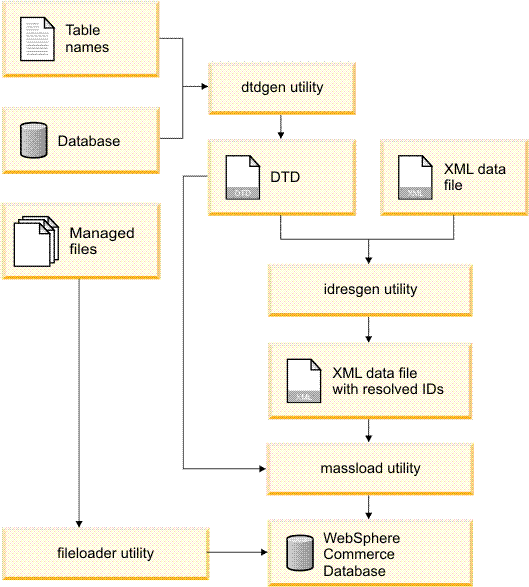Overview of the mass load utilities
To load large amounts of data and to update data in your WebSphere Commerce database with the mass load utilities, follow these basic steps:
- Generate a document type definition (DTD) with the dtdgen utility.
- Resolve identifiers in the input files with the idresgen utility.
- Load the data with the massload utility.
 The massload utility
is deprecated for WebSphere Commerce Version 7 Feature Pack 6. The
Data Load utility is the recommended command-line loading utility.
If you are currently using the mass load utility, you are recommended
to switch to the Data Load utility to load your CSV and XML input
files into your target database. If your system contains scheduled
and automated processes that use massload, it is recommended that
you update these processes to use the Data Load utility. Other WebSphere
Commerce utilities that use the massload utility, such as the acpload
utility, continue to use the massload utility in WebSphere Commerce
Version 7 Feature Pack 6. If you have business reasons to continue
using the massload utility, you can continue to use this utility.
For more information about the Data Load utility, see Overview of the Data Load utility.
You can switch to the Data Load utility by using the
The massload utility
is deprecated for WebSphere Commerce Version 7 Feature Pack 6. The
Data Load utility is the recommended command-line loading utility.
If you are currently using the mass load utility, you are recommended
to switch to the Data Load utility to load your CSV and XML input
files into your target database. If your system contains scheduled
and automated processes that use massload, it is recommended that
you update these processes to use the Data Load utility. Other WebSphere
Commerce utilities that use the massload utility, such as the acpload
utility, continue to use the massload utility in WebSphere Commerce
Version 7 Feature Pack 6. If you have business reasons to continue
using the massload utility, you can continue to use this utility.
For more information about the Data Load utility, see Overview of the Data Load utility.
You can switch to the Data Load utility by using the TableObjectMediatorto load your data when no business object mediator exists for the data that you are loading. For more about theTableObjectMediatorformation, see Data Load utility table-based mediator and builder. - Load managed files with the fileloader utility.
The following diagram illustrates the basic loading process:
